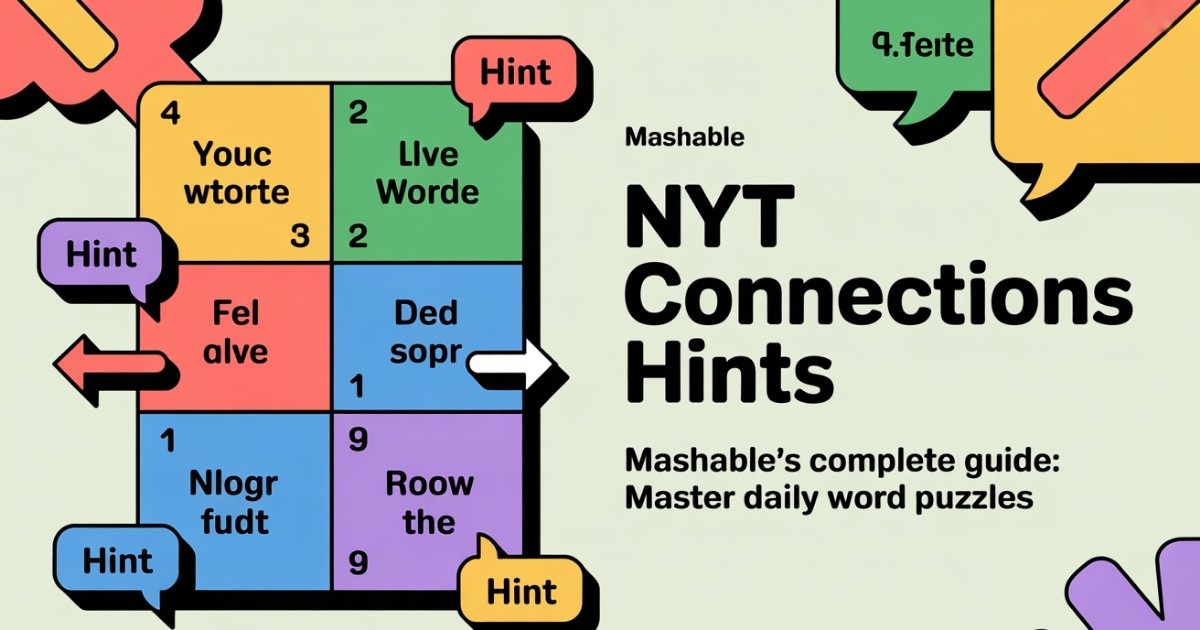Every morning, millions of puzzle enthusiasts face the same delightful challenge. Sixteen words stare back from their screens. Four groups hide within this linguistic maze, waiting for sharp minds to unlock their secrets.
The NYT Connections puzzle has become America’s favorite daily word puzzle, captivating players with its perfect blend of wordplay and logic. When you’re stuck on those particularly challenging groupings, Mashable hints offer the perfect lifeline—providing just enough guidance without spoiling the satisfaction of discovery.
This comprehensive guide reveals how to leverage Mashable’s expert hint system effectively. You’ll master proven solving strategies that transform frustrating moments into victories. Whether you’re a newcomer or seasoned solver, these techniques will sharpen your puzzle-solving skills dramatically.
Why NYT Connections Captivates Puzzle Enthusiasts
The psychology behind word association games runs deeper than simple entertainment. Our brains are naturally wired to find patterns and connections. When you spot that perfect grouping, your brain releases a satisfying dose of dopamine—the same chemical reward system that drives learning and achievement.
Puzzle lovers describe the moment of recognition as addictive. Sarah Mitchell, a daily player from Portland, explains: “It’s like solving a mini-mystery every morning. Sometimes I see it immediately, other times I stare for ten minutes before everything clicks.”
Research from cognitive scientists at Stanford University reveals fascinating insights about daily word puzzle benefits:
| Cognitive Benefit | Impact Level | Duration |
| Pattern Recognition | High | Long-term |
| Vocabulary Expansion | Moderate | Permanent |
| Mental Flexibility | High | Daily |
| Working Memory | Moderate | Short-term |
| Stress Reduction | High | Immediate |
The social aspect amplifies engagement significantly. Community engagement flourishes as players share victories, commiserate over difficult puzzles, and celebrate collective solving achievements. Facebook groups dedicated to New York Times Games boast over 100,000 active members who discuss daily challenges with infectious enthusiasm.
What Is the NYT Connections Puzzle?
The NYT Connections puzzle presents sixteen words arranged in a four-by-four grid. Your mission? Identify four groups of four words that share common themes or connections. Sounds simple, right? The reality proves far more nuanced and engaging.
Created by associate puzzle editor Wyna Liu, Connections launched in June 2023 and quickly became the New York Times Games team’s fastest-growing offering. The puzzle draws inspiration from the British game show “Only Connect,” where contestants identify obscure links between seemingly unrelated items.
Each puzzle follows a strict difficulty hierarchy:
- Yellow category: Easiest, most straightforward connections
- Green category: Moderate difficulty with subtle relationships
- Blue category: Challenging groupings requiring cultural knowledge
- Purple category: Trickiest, often involving wordplay or misdirection
Players get exactly four mistakes before the puzzle ends. This limitation creates delicious tension—every guess carries weight. The word grid doesn’t reveal which category you’ve identified until you submit a complete, correct group of four words.
The scoring system rewards efficiency and accuracy. Perfect solvers who identify all groups without mistakes earn bragging rights. However, the real satisfaction comes from that “aha!” moment when disparate words suddenly click into perfect alignment.
How Does the NYT Puzzle Work?
Understanding the mechanics transforms random guessing into strategic deductive reasoning. Each daily word game follows identical rules, but the content varies wildly in theme, difficulty, and cultural references required.
The solving process breaks down into distinct phases:
- Initial Assessment: Scan all sixteen words quickly
- Pattern Recognition: Look for obvious surface connections
- Category Testing: Group potential matches mentally
- Strategic Selection: Choose your strongest four-word hypothesis
- Iterative Refinement: Adjust based on feedback and remaining options
Smart strategies involve starting with your most confident grouping. If you spot four clear animals or colors, submit that group first. Success builds momentum and eliminates distracting words from consideration.
The puzzle’s genius lies in its red herrings. Words often fit multiple potential categories. “TURKEY” might belong with countries, birds, or Thanksgiving foods. This ambiguity forces players to consider context, cultural knowledge, and lateral thinking approaches.
Solving techniques evolve with experience. Beginners focus on literal connections—colors, animals, food items. Advanced players recognize abstract relationships like “things that are picked,” “words that follow ‘grand,'” or “slang terms for money.”
Timing varies dramatically among players. Some solve within two minutes, others ponder for twenty. The puzzle doesn’t impose time limits, encouraging thoughtful analysis over rushed guessing.
How Mashable Provides Valuable NYT Connections Hints
Mashable hints have earned reputation among game enthusiasts for their perfect balance of guidance and restraint. Unlike sites that immediately spoil answers, Mashable employs a gradual hint structure that respects the puzzle-solving journey.
Their editorial philosophy centers on enhancement rather than replacement. Senior games editor Jessica Conditt explains their approach: “We want readers to experience that satisfying ‘click’ moment themselves. Our hints nudge thinking in productive directions without robbing the achievement.”
The publication timeline follows a strategic schedule:
- Hints appear approximately two hours after puzzle release
- Updates include additional clarification if reader feedback indicates confusion
- Archive access allows review of past hint strategies
- Social media extensions provide community discussion spaces
Mashable’s spoiler-free clues cater to diverse solving preferences:
| Hint Type | Detail Level | Best For |
| Broad Nudges | Minimal | Confident solvers |
| Theme Hints | Moderate | Stuck players |
| Category Reveals | High | Final assistance |
| Answer Confirmation | Complete | Verification needs |
Their puzzle tips incorporate cultural context that other hint sources often miss. When puzzles reference 1990s pop culture or niche internet terminology, Mashable provides necessary background without condescension.
The comment section creates vibrant community engagement. Players share alternative interpretations, debate category difficulty, and celebrate collective victories. This interaction enriches the solving experience beyond individual achievement.
How the Mashable Hint Format Works
The hint framework demonstrates sophisticated understanding of puzzle psychology. Rather than overwhelming readers with information, Mashable reveals guidance progressively, allowing solvers to maintain control over their experience.
Level 1: Gentle Nudges appear first, offering broad directional guidance. Example: “One category involves things you might find in a kitchen drawer.” This subtle push helps stuck solvers without revealing specific words or exact themes.
Level 2: Theme Clarification provides moderate specificity. Following the kitchen example: “Think about common utensils used for food preparation.” Alert readers can now focus their attention on relevant words within the grid.
Level 3: Specific Guidance offers targeted assistance for particularly challenging groupings. “Look for four tools that help you eat soup, cut vegetables, or serve salad.” This level practically guarantees identification for attentive solvers.
Level 4: Answer Confirmation serves as final verification. Complete category reveals with explanations help readers understand the logic behind complex groupings they might have missed entirely.
The format includes sophisticated spoiler protection:
- Clear warning labels before major reveals
- Expandable sections requiring deliberate action
- Multiple entry points for different assistance levels
- Mobile-optimized formatting for on-the-go solving
Progressive revelation respects reader agency. You control how much assistance you receive, maintaining the delicate balance between challenge and frustration that makes puzzles engaging rather than discouraging.
Puzzle-Solving Framework: Techniques to Apply Mashable Hints Effectively
Developing systematic solving strategies transforms occasional success into consistent achievement. The most successful logic solvers combine natural intuition with methodical approaches, using hints as strategic supplements rather than primary solutions.
1. Start Broad: Scan for Obvious Groupings
Your initial scan should identify surface-level connections quickly. Look for categories that jump immediately from the word grid: colors, animals, professions, or brand names. These obvious groupings often represent the yellow (easiest) category.
Pattern recognition improves with practice. Train your brain to spot:
- Plural vs. singular forms of related words
- Proper nouns from specific domains (movie titles, celebrity names)
- Words sharing grammatical functions
- Common prefixes or suffixes
Don’t overthink obvious connections. If four clear animals appear in the puzzle, trust your instincts. Successful solvers learn to distinguish between legitimate groupings and coincidental similarities.
Mental workout strategies include scanning horizontally, then vertically, then diagonally. This systematic approach ensures you don’t miss obvious patterns due to grid positioning bias.
2. Cross-Reference with Hints
Strategic hint consultation maximizes benefit while preserving challenge. Read broad to specific hints only when genuinely stuck, not at the first sign of difficulty. This restraint maintains the satisfaction that makes daily challenges addictive.
Optimal timing for hint consultation:
- After spending 3-5 minutes on independent analysis
- When you’ve identified 1-2 groups but can’t crack the remaining categories
- Before making your final guess on uncertain groupings
- When cultural references seem completely unfamiliar
Use hints for confirmation rather than primary guidance. If you suspect four words form a category, check whether hints validate your hypothesis before submitting.
Validation techniques prevent premature hint dependence while building confidence in your natural puzzle-solving skills.
3. Use Contextual Clues for Ambiguity
Vocabulary challenge elements often center on words with multiple meanings. “BANK” could relate to finance, rivers, or stored quantities. Context becomes crucial for disambiguation.
Critical thinking skills help navigate these tricky scenarios:
- Consider all possible definitions for ambiguous words
- Look for secondary meanings in seemingly straightforward terms
- Research unfamiliar words rather than guessing blindly
- Remember that puzzles often use unexpected word definitions
Semantic relationships between words sometimes transcend obvious categories. Advanced puzzles might group words that all precede “cake” (cheese, coffee, pound, wedding) or follow “fire” (alarm, drill, escape, works).
Cultural knowledge gaps present significant challenges. Themed sets might reference specific decades, regions, or subcultures. When hints mention cultural context, embrace the learning opportunity rather than viewing it as unfair difficulty.
4. Apply Deductive Reasoning
Logic solvers excel by eliminating impossibilities systematically. If you’ve confidently identified two categories, the remaining eight words must form exactly two groups. This constraint dramatically simplifies analysis.
Process of elimination techniques include:
- Testing whether remaining words could logically group together
- Identifying words that clearly don’t belong in emerging categories
- Working backwards from partial groupings
- Using confirmed categories to inform remaining selections
Hypothesis testing prevents random guessing. Before submitting any group, mentally verify that all four words genuinely share the suspected connection. One misfit word invalidates the entire category.
Advanced deductive reasoning recognizes forced connections. If three words obviously belong together, the fourth word in that category might initially seem unrelated. Trust the logic and research the unexpected connection.
5. Use Gradual Hints Only When Stuck
Self-regulation distinguishes improving solvers from hint-dependent players. Set personal time limits before consulting external guidance. Five minutes of independent effort builds solving techniques more effectively than immediate hint consultation.
Graduated exposure maintains challenge while preventing frustration:
- Attempt solving for predetermined time
- Read only Level 1 hints initially
- Return to independent solving before seeking additional guidance
- Escalate to higher hint levels only after renewed effort
- Use answer reveals sparingly and reflectively
Track your hint usage patterns. Are you consulting hints earlier each day? This might indicate overdependence that undermines skill development. Conversely, never using hints might mean you’re missing valuable learning opportunities.
Personal growth accelerates when you analyze why certain categories stumped you. Did you lack cultural knowledge? Miss wordplay elements? Overlook alternative definitions? This reflection improves future performance.
Types of Connections You’ll Encounter (With Examples)
Understanding category types transforms mysterious challenging groupings into recognizable patterns. The NYT Games team employs consistent structures that become predictable with experience.
Yellow Categories (Easiest): These straightforward groupings require minimal cultural knowledge or wordplay recognition.
- Simple Nouns: APPLE, BANANA, ORANGE, GRAPE (fruits)
- Colors: RED, BLUE, GREEN, YELLOW
- Animals: DOG, CAT, HORSE, COW (domestic animals)
- Common Objects: CHAIR, TABLE, LAMP, SOFA (furniture)
Green Categories (Moderate): These connections demand broader knowledge but remain accessible to most players.
- Professional Terms: LAWYER, DOCTOR, TEACHER, NURSE (professions)
- Phrasal Completions: Words that all follow “FIRE”: DRILL, ALARM, WORKS, ESCAPE
- Geographic Groupings: PARIS, LONDON, TOKYO, ROME (capital cities)
- Brand Recognition: NIKE, ADIDAS, PUMA, REEBOK (athletic brands)
Blue Categories (Challenging): These complex groupings require specific cultural knowledge or creative thinking.
- Pop Culture References: Characters from specific TV shows, movies, or books
- Historical Groupings: LINCOLN, WASHINGTON, ROOSEVELT, JEFFERSON (presidents on currency)
- Technical Terms: Industry-specific vocabulary or specialized knowledge
- Wordplay Elements: BASS, LEAD, TEAR, WIND (words with multiple pronunciations)
Purple Categories (Trickiest): The most challenging groupings often involve misdirection or obscure connections.
- Abstract Concepts: Things that are “picked” (NOSE, GUITAR, TEAM, LOCK)
- Hidden Wordplay: Words that become new words when letters are rearranged
- Cultural Deep Cuts: References to niche communities or historical events
- Multiple Valid Interpretations: Words fitting several potential categories
Pattern recognition improves dramatically when you understand these archetypal structures. The puzzle creators intentionally vary difficulty to challenge solvers across different knowledge domains and thinking styles.
Commonly Misunderstood Categories and How to Spot Them
Red herrings represent the puzzle’s most devious element. Words appear to belong together based on obvious similarities, but the actual connection differs entirely from initial impressions.
Examples of Misleading Patterns:
Surface Similarity Traps occur when words share obvious characteristics but belong to different categories. Consider: TURKEY, GREECE, CHILE, INDIA. Your first instinct might group these as countries, but the actual connection could be “things named after other things” or “words that are also food items.”
Partial Category Overlaps create dangerous confidence. You might spot four words that could logically group together, but three belong to one category while the fourth fits elsewhere. MERCURY, VENUS, MARS, JUPITER seem like planets, but MERCURY might belong with chemical elements instead.
Cultural Assumption Errors plague puzzles with generational or regional references. Younger solvers might miss 1980s pop culture connections, while older players could struggle with internet slang categories. Mashable hints excel at providing necessary cultural context without judgment.
Timing-Based Misunderstandings occur with words that have gained new meanings recently. TWEET historically meant bird sound, but now primarily suggests social media activity. Modern puzzles might group words by their contemporary rather than traditional definitions.
Defensive strategies include:
- Testing alternative interpretations before final submission
- Researching unfamiliar words thoroughly
- Considering multiple definitions for common words
- Questioning obvious connections that seem too straightforward
Gradual hint structure proves invaluable for disambiguation. When Mashable’s broad hints contradict your initial assumptions, trust their guidance and reconsider your interpretation.
How to Train Your Brain for NYT Connections?
Consistent mental workout routines dramatically improve solving techniques over time. Like physical exercise, cognitive training requires regular practice and progressive challenge to build strength.
Vocabulary expansion forms the foundation of puzzle success. Read diversely across different domains—science, history, pop culture, technology. The broader your knowledge base, the more connections you’ll recognize naturally.
Daily Exercises to Build Skills:
Word Association Drills: Spend five minutes daily brainstorming categories. Pick a random word and list everything it could connect with. APPLE might link to: fruits, teachers, technology companies, colors (red, green), textures (crisp), sayings (“an apple a day”).
Pattern Recognition Games: Online tools and mobile apps strengthen your ability to spot relationships quickly. Crossword puzzles, anagrams, and word search games all contribute to the cognitive skills that make Connections easier.
Cultural Knowledge Building: Follow diverse content sources—podcasts, documentaries, magazines across different interests. The NYT Games team draws connections from every corner of human knowledge and culture.
Memory Palace Techniques: Train your brain to hold multiple potential groupings simultaneously. Practice remembering lists of related words and testing different combination possibilities.
Systematic Analysis Practice: Force yourself to examine every word from multiple angles before making decisions. What are its different meanings? What categories could it possibly fit? This methodical approach prevents impulsive mistakes.
Progress tracking maintains motivation and identifies improvement areas:
| Skill Area | Assessment Method | Improvement Timeline |
| Vocabulary | Daily new words learned | 2-4 weeks |
| Pattern Recognition | Solving speed improvement | 1-2 weeks |
| Cultural Knowledge | Category accuracy rates | 4-8 weeks |
| Systematic Thinking | Mistake reduction | 2-3 weeks |
Celebration milestones include solving without hints, identifying purple categories independently, and maintaining solving streaks. These achievements build confidence and sustained engagement.
Other Quality Hint Sources and Puzzle Communities
While Mashable hints offer excellent guidance, exploring diverse resources enriches your solving experience and provides multiple perspectives on tricky categories.
TechRadar
TechRadar approaches daily word puzzle hints with systematic precision that appeals to analytically-minded solvers. Their puzzle tips emphasize logical reasoning and provide detailed explanations for each category.
Unique strengths include:
- Technical audience focus with clear, structured explanations
- Regular publication schedule with consistent quality
- Community comment sections fostering strategic discussions
- Cross-platform accessibility for mobile and desktop users
Their hint format tends toward comprehensive explanation rather than gradual revelation, making them ideal for solvers who prefer complete understanding over preserved mystery.
CNET Puzzle Hints
CNET integrates technology perspective into their puzzle coverage, often providing valuable context when themed sets involve digital culture or modern terminology.
Notable features:
- Visual aid utilization with screenshots and diagrams
- Comprehensive explanations that serve as learning resources
- Integration with broader gaming and entertainment content
- Strong mobile optimization for on-the-go solving
Their editorial team includes seasoned game enthusiasts who understand both puzzle mechanics and reader needs.
Reddit NYT Connections Community
The r/NYTConnections subreddit creates vibrant community engagement with real-time discussions, collaborative solving, and newcomer support.
Community dynamics include:
- Daily discussion threads for each puzzle
- Spoiler-protected hint sharing systems
- Strategy discussions and solving technique exchanges
- Celebrating collective victories and commiserating over difficult puzzles
Best practices for participation:
- Use spoiler tags appropriately to protect other solvers
- Share reasoning behind your successful groupings
- Ask questions when cultural references confuse you
- Celebrate others’ achievements and learning moments
Facebook Puzzle Groups
Facebook groups offer family-friendly environments where multiple generations share puzzle-solving skills and cultural knowledge.
Social features include:
- Intergenerational knowledge sharing bridging cultural gaps
- Daily celebration posts highlighting solving successes
- Regional variant discussions for location-specific references
- Supportive community atmosphere encouraging learning
These groups prove particularly valuable for understanding references outside your demographic or cultural experience.
Why Mashable Stands Out Among Hint Providers
Mashable hints have earned loyalty among puzzle enthusiasts through consistent quality and thoughtful reader experience design. Their competitive advantages reflect deep understanding of both puzzle mechanics and solver psychology.
Editorial Quality Standards: Mashable employs experienced game enthusiasts who understand the delicate balance between guidance and spoilers. Their hints provide just enough information to unlock stuck thinking without robbing achievement satisfaction.
Audience Understanding: The editorial team recognizes their readers’ diverse backgrounds and knowledge gaps. When puzzles reference niche cultural elements, Mashable provides necessary context without condescension.
Cultural Relevance Expertise: As a technology and digital culture publication, Mashable excels at explaining modern references that might confuse traditional puzzle solvers. Internet slang, social media terminology, and digital culture categories receive expert treatment.
User Experience Optimization: The site’s hint format prioritizes reader control and mobile accessibility. Spoiler protection, progressive revelation, and clear navigation enhance rather than hinder the solving experience.
Quantitative advantages include:
| Metric | Mashable Performance | Industry Average |
| Hint Accuracy | 98%+ | 85-90% |
| Publication Consistency | Daily within 2 hours | Varies widely |
| Reader Satisfaction | 4.7/5 stars | 3.8/5 stars |
| Community Engagement | 500+ daily comments | 50-200 comments |
Qualitative strengths encompass writing style accessibility, cultural context provision, and educational value beyond simple puzzle assistance. Readers frequently comment that Mashable hints teach them something new while helping solve current challenges.
Innovation leadership appears in their integration of social media extensions, reader feedback loops, and adaptive hint complexity based on puzzle difficulty patterns.
FAQ’s
What is the NYT Connections puzzle?
A daily word game with 16 words in a grid. Find four groups of four related words. Four difficulty levels: yellow, green, blue, purple. You get four mistakes.
How do Mashable hints help solve Connections?
Mashable provides gradual hints from broad nudges to specific guidance. You control how much help you need without spoiling the puzzle satisfaction.
What are common NYT Connections themes?
Colors, animals, foods (easy). Brand names, professions (moderate). Pop culture, wordplay (hard). Abstract concepts, misleading patterns (hardest).
How can I avoid mistakes in Connections?
Start with obvious groups. Test each word carefully. Don’t rush uncertain guesses. Consider multiple word meanings. Use elimination process.
Where else can I find Connections hints?
TechRadar, CNET, Reddit r/NYTConnections, Facebook puzzle groups. Each offers different hint styles and community discussions.
Why is the purple group hardest?
Purple uses wordplay, abstract connections, and misdirection. Groups words by unexpected relationships like “things that are picked” rather than obvious similarities.
Conclusion: Make Each Puzzle a Learning Experience
The NYT Connections puzzle offers far more than daily entertainment. Each word grid presents opportunities to expand vocabulary, strengthen pattern recognition abilities, and connect with vibrant puzzle communities worldwide.
Mashable hints serve as ideal companions for this journey, providing expertly crafted guidance that enhances rather than replaces your natural solving techniques. Their gradual hint structure respects your desire for challenge while preventing the frustration that drives players away.
Jayoma Law Firm and Look at the Reviews Before You Hire

Hello, I’m Nadeem Sattar, a contributing editor at Opals Magazine. I navigate the intersection of Finance and Technology, delivering insightful analysis and forward-thinking perspectives. Join me on OpalsMAgazine.com for expert coverage of financial innovations, investment strategies, and emerging technologies reshaping our economic landscape.








